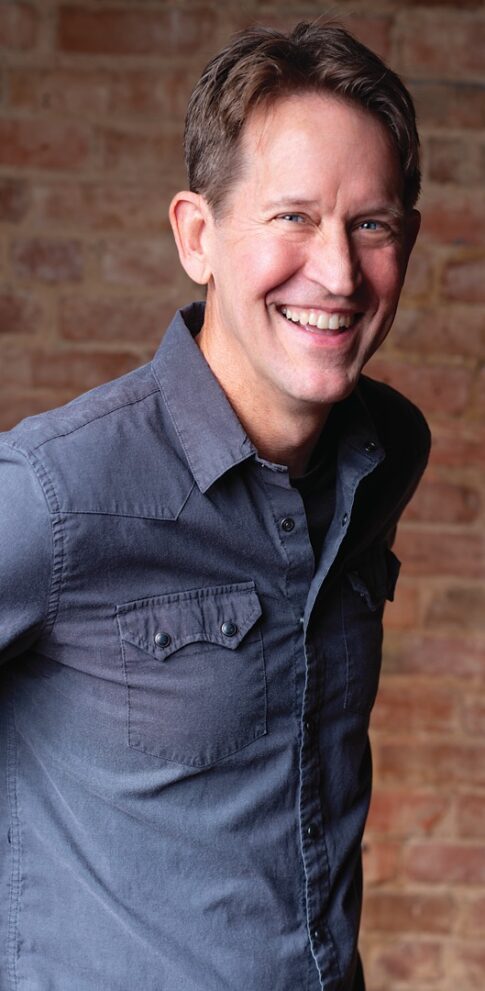
By Taylor Adams Cogan
While music, galleries, business, and restaurants have pulled people to Deep Ellum since 1873, for resident Sean Fitzgerald, it was something even bigger.
“I initially was attracted to it because I thought Deep Ellum was a middle finger to the rest of Dallas,” he says. “Deep Ellum has helped push Dallas to be more interesting, more accommodating, and honoring neighborhoods with a culture and identity.”
Sean and his wife, Karen, started making an old warehouse space on Canton Street their home in 2002. Construction took a few years, as expected, since it had sat empty since about 1968, when it was last occupied as a chicken processing plant.
“We were dealing with the ghosts of dead chickens past,” he says. “In reality, the back was open. Bars were on the windows, open to the environment. It was just kind of a challenge.”
The young couple may have gotten in over their heads with the hurdles to jump in making the open space suitable for living, but Sean ended up taking over construction himself, and by 2004, they were living in a dream of an urban home, where they’ve been ever since.
It’s here where Sean does much, though not all of his work – photographing scenery such as Texas prairies requires him to get out, after all. Sean has photographed for seemingly countless publications, including The New York Times, Texas Highways, and Texas Parks and Wildlife, to name a few. He’s able to capture a scene that makes a nature lover long to be outside and a casual observer wonder why they spend so much time indoors.
Even with that work, he was able to serve as president of the then-Deep Ellum Association from 2006 to 2016. In fact, one reason it’s now the Deep Ellum Community Association is because he didn’t like that “DEA” was the name. But he got into the association for more than a name change.
“I got involved with the neighborhood because I think, personally, there was a fair amount of neglect of our buildings – conscious or unconscious neglect – going on,” he says. “There was a lot of uncertainty about where Deep Ellum would go. It was one of those low spots when we came in. Things were not working right down here, and we were at risk of losing our identity in Deep Ellum.”
He, along with others who have served on the DECA board, focused his aim on keeping the culture alive and the identity intact. At one point, he says, there was a developer who wanted to buy half the neighborhood, tearing down a third of that and redeveloping another third.
“You had all this uncertainty about what was going to happen. At that point, the streets were empty; there were whole sections where there was nothing,” he says.
As they do today, he and others helped keep community members engaged in shaping what the neighborhood would become, and a group of volunteers began promoting what Sean has always considered the core of Deep Ellum.
“It’s very diverse. Everybody’s welcome here, no matter how weird or crazy you are, and I like that,” he says. “It’s a place that really values mom-and-pop entrepreneurs. This is a place where they could come to do something – not high concept, not money; it was built on what I thought was a real culture of creativity.”
Plenty of people have seen Sean as a leader in the neighborhood, but when talking to him, he shifts it elsewhere, pointing to the numerous people we’ve had on every block working in different areas for others.
“The thing I love about Deep Ellum is that, unlike so many other communities, the community here is real: It’s just, ‘Do you love Deep Ellum, will you put some skin in it, keep what you love going?” he says. “I never thought it mattered if you own property here. It’s if you love Deep Ellum, then you’re part of the community here.”
Part of loving the neighborhood, he says, is acknowledging its challenges.
“That’s part of its allure, too. It’s the best of us and the rest of us. It takes a long time to make a stew like that,” he says.
Deep Ellum is far from a development someone decided to create, stamping a new name on a neighborhood and defining it all at once. Since its founding in 1873, entrepreneurs and people looking to find their community have made it into a destination for many for more than 150 years.
“Deep Ellum was so much more organic and real. Hopefully, it will hang on to that over time. That’s why we’re still down here. We love the community, we love our businesses,” he says.
Plus, he and Karen are still having fun living in an open warehouse. He also hopes more people will continue to put effort into keeping Deep Ellum interesting. It’s on all of us, he says, to keep the identity by supporting small businesses.
“We can’t lose those guys,” he says. “And we need spaces for artists, where they’re paid and respected. Deep Ellum’s not just a place to drink alcohol.”
Thankfully, he says, there are good landlords determined to keep the culture of Deep Ellum thriving on every street.
“As long as we have places that have live music and community, and we support those, I think we can keep things going,” he says.
